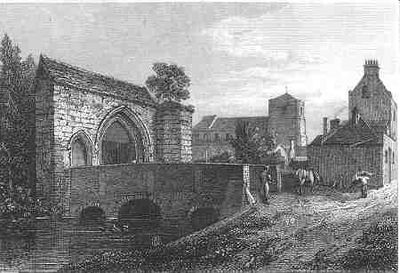Annotation:Walton Abbey: Difference between revisions
No edit summary |
No edit summary |
||
| Line 2: | Line 2: | ||
---- | ---- | ||
<p><font face="garamond, serif" size="4"> | <p><font face="garamond, serif" size="4"> | ||
'''WALTON ABBEY.''' AKA – “Waltom Abbey,” “Waltham Abbey.” AKA and see “[[My Lady's Courant]].” English, Country Dance Tune (2/2 time). F Major. Standard tuning (fiddle). AABB. | '''WALTON ABBEY.''' AKA – “Waltom Abbey,” “Waltham Abbey.” AKA and see "[[Devil in the Bush]]," “[[My Lady's Courant]]," "[[Prince of Orange's Delight (The)]].” English, Country Dance Tune (2/2 time). F Major. Standard tuning (fiddle). AABB. Graham Christian (2015) finds the first appearance of the tune in print is in the 2nd edition of Playford's '''Apollo's Banquet''' (1678) under the title "[[Figure Dance (A)]]," and in the 6th and 7th editions (1690 & 1693) as "[[Prince of Orange's Delight (The)]]." The melody and instructions for a longways dance were printed in Henry Playford’s '''Dancing Master''', second supplement, 9th edition [http://www.izaak.unh.edu/nhltmd/indexes/dancingmaster/Dance/Play1658.htm] (1698) and in all subsequent editions of the long-running series until the end, with the 18th edition of 1728. The tune and dance were also published by John Walsh in the first and subsequent editions of his '''Complete Country Dancing Master''' (London, 1718, 1731 & 1754). London musician Thomas Hammersley included it in his 1790 copybook, giving the title as “Devil in the Bush,” with “Walton Abbey” as an alternate title. | ||
<br> | <br> | ||
<br> | <br> | ||
| Line 16: | Line 16: | ||
</font></p> | </font></p> | ||
<p><font face="garamond, serif" size="4"> | <p><font face="garamond, serif" size="4"> | ||
''Printed sources'': Barlow ('''The Complete Country Dance Tunes from Playford’s Dancing Master'''), 1985; No. 391, p. 91. Barnes ('''English Country Dance Tunes, vol. 2'''), 2005; p. 139 (appears as “Waltham Abbey”). John Walsh ('''Complete Country Dancing-Master, Volume the Fourth'''), London, 1740; No. 124. | ''Printed sources'': Barlow ('''The Complete Country Dance Tunes from Playford’s Dancing Master'''), 1985; No. 391, p. 91. Barnes ('''English Country Dance Tunes, vol. 2'''), 2005; p. 139 (appears as “Waltham Abbey”). Christian ('''A Playford Assembly'''), 2015; p. 128. John Walsh ('''Complete Country Dancing-Master, Volume the Fourth'''), London, 1740; No. 124. | ||
<br> | <br> | ||
<br> | <br> | ||
Revision as of 12:58, 27 August 2017
Back to Walton Abbey
WALTON ABBEY. AKA – “Waltom Abbey,” “Waltham Abbey.” AKA and see "Devil in the Bush," “My Lady's Courant," "Prince of Orange's Delight (The).” English, Country Dance Tune (2/2 time). F Major. Standard tuning (fiddle). AABB. Graham Christian (2015) finds the first appearance of the tune in print is in the 2nd edition of Playford's Apollo's Banquet (1678) under the title "Figure Dance (A)," and in the 6th and 7th editions (1690 & 1693) as "Prince of Orange's Delight (The)." The melody and instructions for a longways dance were printed in Henry Playford’s Dancing Master, second supplement, 9th edition [1] (1698) and in all subsequent editions of the long-running series until the end, with the 18th edition of 1728. The tune and dance were also published by John Walsh in the first and subsequent editions of his Complete Country Dancing Master (London, 1718, 1731 & 1754). London musician Thomas Hammersley included it in his 1790 copybook, giving the title as “Devil in the Bush,” with “Walton Abbey” as an alternate title.

Waltham Abbey, Essex, dates from pre-Norman times, having been founded by King Harold Godwinson (Harold II). It was a favorite stopping-place for the gentry who hunted Waltham Forest, and was the last abbey to be dissolved in England, in 1540.
Source for notated version:
Printed sources: Barlow (The Complete Country Dance Tunes from Playford’s Dancing Master), 1985; No. 391, p. 91. Barnes (English Country Dance Tunes, vol. 2), 2005; p. 139 (appears as “Waltham Abbey”). Christian (A Playford Assembly), 2015; p. 128. John Walsh (Complete Country Dancing-Master, Volume the Fourth), London, 1740; No. 124.
Recorded sources:
